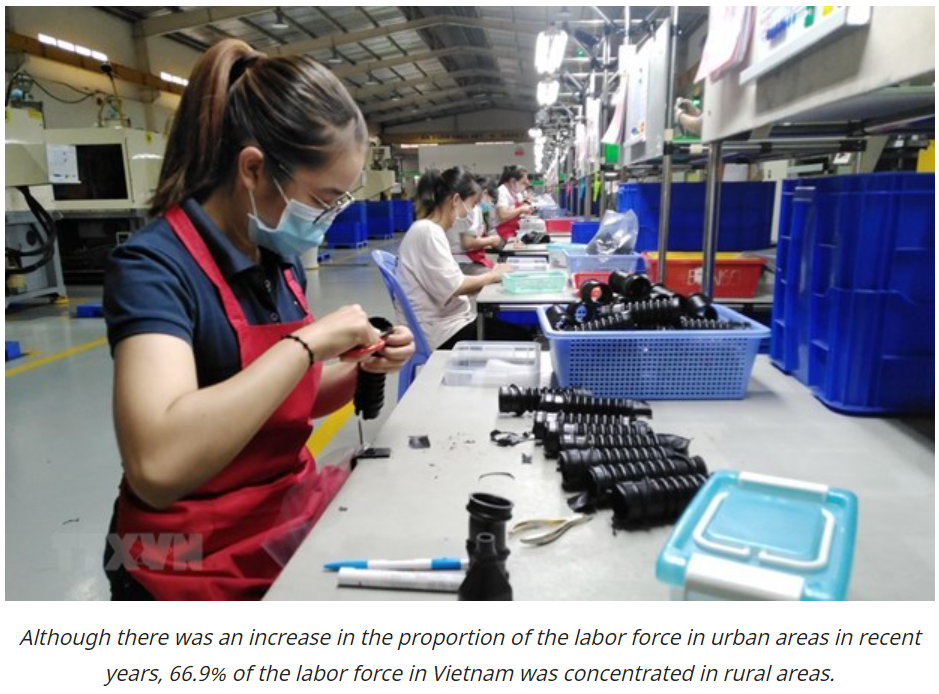The biggest decline in Vietnamese labor market in a decade
The Covid-19 pandemic caused turbulence in Vietnam’s labor market in 2020.
For the first time in 10 years, Vietnam’s economy witnessed a serious decline in the number of participants in the labor market and the number of employed people. The average income of workers also fell. The indicators of unemployment and underemployment both increased sharply in contrast to the decreasing trend in recent years.
Citing the Labor and Employment Survey Report 2020 of the General Statistics Office of Vietnam, the average labor force of the whole country in 2020 was 54.84 million people, down 924,000 people from the previous year. The labor force consisted of 53.6 million employed people and more than 1.2 million unemployed.
Although there was an increase in the proportion of the labor force in urban areas in recent years, 66.9% of the labor force in Vietnam was concentrated in rural areas.
About 40.9% of employees work 40-48 hours/week and it is a worrying figure that up to 30.9% of employees worked more than 48 hours/week. The number of employees working less than 20 hours/week accounted for a low proportion (6.6%). The proportion of employees working under 35 hours/week was 21.8%.
Another concern is that the proportion of trained labor force in the country was still low. Out of a total of 54.82 million people aged 15 and over in the national labor force, only about 13.2 million people were trained, accounting for about 24.0% of the total labor force. There were more than 41.6 million people (accounting for about 76.0% of the labor force) who were not trained to achieve a certain level of technical expertise.
Thus, the human resource of Vietnam is young and abundant, but the level of skills and technical expertise is still low.
The income gap between the group of people with a “university degree or higher” and the group “without professional and technical training” is about 1.5 times. The group of people with a “university or higher degree” earned more than 8.7 million VND/month, while the group without professional training earned only 5.7 million VND/month.
This shows that if trained, laborers will create more added value to themselves, their families and society.
Female workers were disadvantaged more than men
In 2020, the country had more than 1.2 million unemployed people; of which the urban area accounted for 52.9%, 5.6 percentage points higher than in 2019. The number of women accounted for 56.1% of the total unemployed, 8.3 percentage points higher than the previous year. Thus, when the labor market experiences an incident, urban workers are affected more than rural workers, and female workers are more disadvantaged than men.
The unemployment rate of people of working age (men aged 15-59 years and women aged 15-54 years) in Vietnam in 2020 was 2.48%.
Young people aged 15-24 years old accounted for 35.4% of the total number of unemployed people. In 2020, the youth unemployment rate (7.21%) was 4.4 times higher than the unemployment rate for people aged 25 and over (1.63%).
“Like many other developing countries in the world, unemployment is often much higher in urban areas, while underemployment is common in rural areas,” the General Statistics Office commented.
During the Covid-19 pandemic, the issue of social security for the unemployed workforce in urban areas is also a matter of concern, especially in big cities.
Notably, of the unemployed, the data shows that the proportion of the group of people with a “university or higher degree” was the highest (20.7%) followed by the group of people with a “secondary and high school degree” with 19.0% and 16.7%.
The group with the lowest rate of unemployed people was “unschooled/primarily trained” with 1.6% and 4.6%, respectively.
The group of people with the highest rate of unemployment were those with a university degree or higher, possibly because they are trying to find a job that matches their training level.
The group with “secondary and high school degree” also had a relatively high rate of unemployment, possibly due to the fact that many students who have just graduated from lower and upper secondary schools continued their studies and were not ready to enter the labor market.
According to the General Statistics Office, this situation is due to the fact that the group of workers with low professional qualifications are often willing to do simple and unskilled jobs with low wages while those with higher education level try to find a job with a more suitable income.
This partly reflects the job quality of Vietnam’s labor market, which is still low, and unable to meet the needs of workers with high professional and technical skills.
This is something Vietnam needs to pay attention to in order to attract more high-quality foreign investors.
Luong Bang
Source: https://vietnamnet.vn/en/feature/the-biggest-decline-in-vn-labor-market-in-a-decade-771457.html


 Thailand
Thailand




